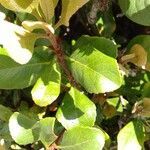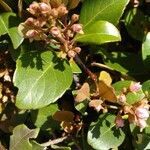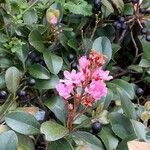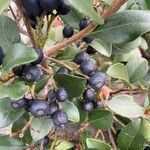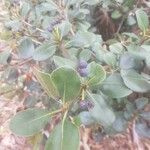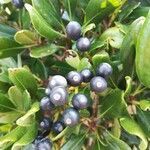Shrubs, rarely small trees, to 4 m tall. Branchlets purplish brown when young, grayish brown when old, terete, initially brown tomentose, glabrous when old. Petiole 0.5–1.8 cm or nearly absent, slightly brown tomentose or, subglabrous; stipules caducous, lanceolate, sparsely brown tomentose, apex acuminate; leaf blade ovate, oblong, rarely obovate, oblong-lanceolate, narrowly elliptic or lanceolate-elliptic, (2–)4–8 × 1.5–4 cm, leathery, veins prominent abaxially, reticulate veins conspicuous abaxially and conspicuous or not adaxially, abaxially pale, glabrous or sparsely tomentose, adaxially lustrous, glabrous, base attenuate, margin crenulate, serrate, or obtusely serrate, apex obtuse, acute, acuminate, or long caudate. Panicle or racemes terminal, many-or few flowered; peduncle and pedicels rusty tomentose; bracts and bractlets caducous, lanceolate or narrowly lanceolate, 2–7 mm, both surfaces initially brown tomentose, densely so at margin, soon glabrescent, apex acuminate. Pedicel 0.5–1.5 cm, initially brown tomentose, soon glabrescent. Flowers 1–1.3(–1.5) cm in diam. Hypanthium tubular, brown tomentose at margin and on both surfaces or glabrous. Sepals triangular-lanceolate or linear, 4.5–6 mm, both surfaces slightly brown tomentose or glabrous, apex acute. Petals white or pinkish, obovate or lanceolate, 5–7 × 4–5 mm, pubescent basally, apex obtuse. Stamens 15, ca. as long as or shorter than petals. Ovary glabrous, 2-or 3-loculed, with 2 ovules per locule; styles 2 or 3, connate at base, subglabrous. Pome purplish black, globose, 5–8 mm in diam., glabrous; fruiting pedicel 5–10 mm, glabrous; sepals caducous, leaving an annular ring. Fl. Apr, fr. Jul–Aug.
More
Shrubs or small trees. Leaves more or less crowded, oblong to obovate-oblong, 3-7 by 1-2.5 cm, base gradually narrowed, margin serrate, apex acute to obtuse and acuminate, with c. 5 pairs of nerves, herbaceous to subcoriaceous, with some hairs when very young, soon glabrous. Petiole up to 0.5 cm long. Stipules small, caducous. Racemes compound, up to 13 cm long, the peduncle very short, rachises practically glabrous, pedicels up to 5 mm long. Flowers fragrant. Hypanthium 3-3.5 mm high, sparsely hairy outside. Sepals pointed-triangular, up to 5 by 1-1.5 mm long. Petals up to 6 mm long, usually white, sometimes pinkish. Ovary glabrous, styles loosely connate at base. Fruits globular, c. 6 mm diam., black when ripe.
An evergreen shrub. It grows 2 m tall. The leaves are leathery, simple and oval. They have teeth along the edge. The leaves are 5 cm long. They are dark green. The tips are pointed. The flowers are small and rose like. They are pink or white and occur in branched clusters. The fruit is a small purple or black fleshy fruit.
